
The Ohio Clock (or Senate Clock) is a clock in the United States Capitol. The United States Senate ordered the clock from Thomas Voigt in 1815, and it has stood in or near the Senate Chamber since 1859.

The Ohio Clock (or Senate Clock) is a clock in the United States Capitol. The United States Senate ordered the clock from Thomas Voigt in 1815, and it has stood in or near the Senate Chamber since 1859.
Senator David Daggett of Connecticut ordered the eleven-foot (3.35 m) tall clock in late December 1815 from Philadelphia clockmaker Thomas Voigt for use in the Old Brick Capitol. [1] [2] [3] The clock was delivered in 1817 to the Old Senate Chamber and was moved to the corridor outside the newly finished Senate Chamber in 1859. [4] There is no evidence to support the claim that senators hid illegal liquor in the clock during the Prohibition period. [5] The glass covering the clock's face was broken in the 1983 United States Senate bombing. [3] The clock, which was renovated in Boston in 2010, is wound weekly and keeps accurate time. [3]
The source of the clock's name is unknown. [6] One myth is that the clock was meant to commemorate Ohio's admission to the Union as the 17th state because the shield on the front of the clock's case has seventeen stars in it. However, there is no record that shows the clock celebrates Ohio's statehood and the clock was ordered twelve years after Ohio became a state, at a time when there were already eighteen states. [1] [6]
![]() This article incorporates public domain material from websites or documents of the United States Senate .
This article incorporates public domain material from websites or documents of the United States Senate .

The United States Capitol, often called The Capitol or the Capitol Building, is the seat of the United States Congress, the legislative branch of the federal government. It is located on Capitol Hill at the eastern end of the National Mall in Washington, D.C. Although no longer at the geographic center of the federal district, the Capitol forms the origin point for the street-numbering system of the district as well as its four quadrants.
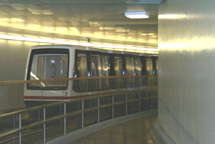
The subway system of the United States Capitol Complex in Washington, D.C., consists of three underground electric people mover systems that connect the United States Capitol to several congressional office buildings – all of the Senate buildings and one of the House buildings.

A quorum is the minimum number of members of a group necessary to constitute the group at a meeting. In a deliberative assembly, a quorum is necessary to conduct the business of that group. According to Robert's Rules of Order Newly Revised, the "requirement for a quorum is protection against totally unrepresentative action in the name of the body by an unduly small number of persons." In contrast, a plenum is a meeting of the full body. A body, or a meeting or vote of it, is quorate if a quorum is present.
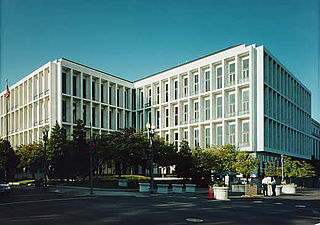
The Philip A. Hart Senate Office Building is the third U.S. Senate office building, and is located on 2nd Street NE between Constitution Avenue NE and C Street NE in Washington, D.C., in the United States. Construction began in January 1975, and it was first occupied in November 1982. Rapidly rising construction costs plagued the building, creating several scandals. The structure is named for Philip Hart, who served 18 years as a senator from Michigan. Accessed via a spur of the United States Capitol Subway System, the building features a nine-story atrium dominated by massive artwork, and a large Central Hearing Facility which provides television facilities as well as extensive seating.

The Old Brick Capitol in Washington, D.C., served as the temporary meeting place of the Congress of the United States from 1815 to 1819, while the Capitol Building was rebuilt after the burning of Washington.

The California State Senate is the upper house of the California State Legislature, the lower house being the California State Assembly. The state senate convenes, along with the state assembly, at the California State Capitol in Sacramento.

The National Statuary Hall Collection in the United States Capitol is composed of statues donated by individual states to honor persons notable in their history. Limited to two statues per state, the collection was originally set up in the old Hall of the House of Representatives, which was then renamed National Statuary Hall. The expanding collection has since been spread throughout the Capitol and its Visitor's Center.

A joint session of the United States Congress is a gathering of members of the two chambers of the bicameral legislature of the federal government of the United States: the Senate and the House of Representatives. Joint sessions can be held on any special occasion, but are required to be held when the president delivers a State of the Union address, when they gather to count and certify the votes of the Electoral College as the presidential election, or when they convene on the occasion of a presidential inauguration. A joint meeting is a ceremonial or formal occasion and does not perform any legislative function, and no resolution is proposed nor vote taken.
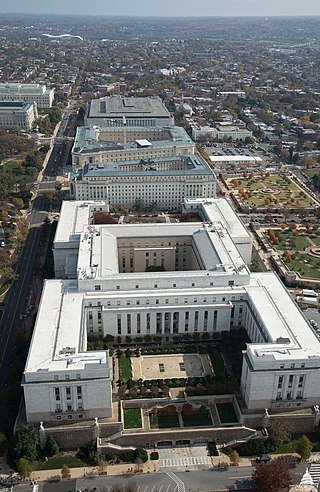
The congressional office buildings are the office buildings used by the United States Congress to augment the limited space in the United States Capitol. The congressional office buildings are part of the Capitol Complex, and are thus under the authority of the Architect of the Capitol and protected by the United States Capitol Police. The office buildings house the individual offices of each U.S. Representative and Senator as well as committee hearing rooms, staff rooms, multiple cafeterias, and areas for support, committee, and maintenance staff.

Tiber Creek or Tyber Creek, originally named Goose Creek, is a tributary of the Potomac River in Washington, D.C. It was a free-flowing creek until 1815, when it was channeled to become part of the Washington City Canal. Presently, it flows under the city in tunnels, including under Constitution Avenue NW.

The United States Capitol features a central rotunda below the Capitol dome. Built between 1818 and 1824, it has been described as the Capitol's "symbolic and physical heart".

The Old Senate Chamber is a room in the United States Capitol that was the legislative chamber of the United States Senate from 1810 to 1859 and served as the Supreme Court chamber from 1860 until 1935. It was designed in Neoclassical style and is elaborately decorated. In 1976 as part of the United States Bicentennial celebrations, it was restored to the appearance of when it served the Senate in the 1850s; it is preserved as a museum and for the Senate's use.
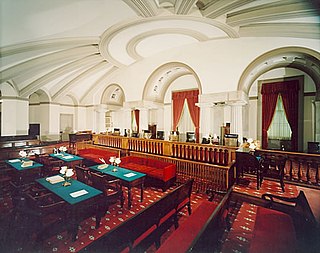
The Old Supreme Court Chamber is the room on the ground floor of the North Wing of the United States Capitol. From 1800 to 1806, the room was the lower half of the first United States Senate chamber, and from 1810 to 1860, the courtroom for the Supreme Court of the United States.

The United States Senate is the upper chamber of the United States Congress. The United States Senate, along with the lower chamber of Congress, the United States House of Representatives, comprise the federal bicameral legislature of the United States. The Senate and House maintain authority under Article One of the U.S. Constitution to pass or defeat federal legislation. The U.S. Senate has exclusive power to confirm U.S. presidential appointments, ratify treaties, exercise advice and consent powers, try cases of impeachment brought by the House, all of which provide a check and balance on the powers of the executive and judicial branches of government.
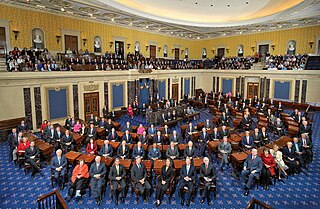
The United States Senate Vice Presidential Bust Collection is a series of 46 busts in the United States Capitol, each one bearing the likenesses of a vice president of the United States. Each sculpture, from John Adams to Dick Cheney, honors the role of the vice president as both a member of the executive branch and as president of the Senate.

The Daniel Webster Senate Page Residence, also known as Webster Hall, is the residence for United States Senate Pages. The building is a former funeral home and underwent an $8 million refurbishment in 1995, converting it to its current state. It is located near the Hart Senate Office Building, giving pages the ability to walk to and from work. Pages are required to live in the building during the school year. The building has 24/7 protection by the United States Capitol Police both indoors and on foot around the building. The United States Senate Page School is located in the basement of the building. The residential portion of Webster Hall is staffed by adult employees of the United States Senate Page Program, while the school is staffed by employees of the United States Senate Page School. Pages are supervised by proctors, generally graduate students, who are employed by the United States Senate Page Program. $780 per month is deducted from a page's paycheck to fund room and board. In addition to the proctors, there is a program director and an administrative aide. There are two living quarters with one being designated for female students and the other for male students. There are laundry and kitchen facilities in the building. Along with the 24/7 protection by the United States Capitol Police, visitors are required to sign in and all individuals must present some form of identification. During summer sessions pages may request arrangements for alternative housing.

The 1858–59 United States Senate elections were held on various dates in various states. As these U.S. Senate elections were prior to the ratification of the Seventeenth Amendment in 1913, senators were chosen by state legislatures. Senators were elected over a wide range of time throughout 1858 and 1859, and a seat may have been filled months late or remained vacant due to legislative deadlock. In these elections, terms were up for the senators in Class 2.

The United States Senate Chamber is a room in the north wing of the United States Capitol that has served as the legislative chamber of the United States Senate, since January 4, 1859. The Senate first convened in its current meeting place after utilizing Federal Hall, Congress Hall, and the Old Senate Chamber in the Capitol building for the same purpose.

The Vice President's Room is the vice president's office in the United States Capitol, added during the 1850s expansion.
Thomas Voigt was an American clockmaker. He apprenticed under his father, Henry Voigt, an American Revolution era clockmaker and inventor.